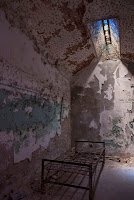I really want to learn how to work with stained glass, but today I’m going to do the next best thing. I’m going to talk to you about Judith Schaechter, a Philadelphia based stained glass artists with works in the Victoria and Albert Museum, the Metropolitan Museum of Art, and my very own Corning Museum of Glass.
Oh, and she’s also alive. At this point, I might as well get rid of my “no living artists” rule altogether. I seem to be breaking it a lot.
Taking Schaechter’s works at face value, I would have chosen Body Bag, a work that depicts a speech-bubble-like mass containing layered images of dinosaur bones, bodies, and constellations emerging from a slightly unzipped body bag. It’s as if a corpse were dreaming or the soul returning to the primordial cosmos of life. Like many of Schaechter’s works, it’s beautifully comic, dark, ambiguous, and evocative all at once. And I love the contrast between the flat, geometric background and the deep, flowing forms of the bubble.
 |
| Judith Schaechter, Body Bag, stained glass, 71.1 x 119.4 cm. |
But like most of Schaechter’s stained glass windows, Body Bag isn’t really a window. It’s a panel installed in a light box. It has no permanent context, and the unchanging artificial light makes it look more like a television or computer screen than a window. So, when I read about Schaechter’s installation at Philadelphia’s Eastern State Penitentiary, I chose a work from that instead.
Eastern State Penitentiary opened in 1829 as an innovative new prison dedicated to “confinement in solitude with labor.” While prisoners had regular contact with wardens, guards, and, oddly enough, tourists, there was no inter-prisoner-mingling and no visits from family or friends. For the most part, prisoners were left alone with their thoughts in the hopes that they would reflect on their past and repent. Hence the word “penitentiary.” But all things must end. Eastern State closed in 1971 and is now a National Historic Landmark and museum.
Schaechter’s artist installation opened in early 2012 and was titled The Battle of Carnival and Lent after the show’s centerpiece, a large transom window outside cellblock 11 (itself named for the Bruegel painting). The installation also consisted of 16 other stained glass windows inspired by Eastern State’s bleak history and addressing “the psychological boarder territory between ‘spiritual aspiration’ and human suffering.” I only learned about the installation last week, and I’m upset about it. It was deinstalled December 3. I missed it by less than a month and a half.
Judith Schaechter, Mary Magdalene, 2012, stained glass, 119.38 x 11.43 cm.
The work I chose is Mary Magdalene, part of a group of ten narrow stained glass skylights called Con/Fines. The group was located in cellblock 8 and depicts five mythic “prisoners,” including Prometheus, Atlas, Andromeda, and Noah, paired with five ornamental windows. The windows’ odd dimensions enhance the feeling of imprisonment and struggle. Although Schaechter typically avoids cropping the human form, I’m glad she did here. Having bits and pieces go off the picture plane makes the windows seem more vibrant and dynamic.
Mary Magdalene itself depicts a window at Eastern State Penitentiary, complete with the decaying walls of the cell around it. Magdalene lies naked and limp on a bare mattress as the shadows of the bars criss-cross her body. She seems to have given up, succumbing to her suffering and becoming one with her meager surroundings. When we look at Mary within the context of the cell, the real cell, where the window was installed, the presence of an absent prisoner joining Mary in captivity seems palpable. Crumbling walls and an empty bed frame mirror Mary’s composition. It’s ghostly. The whole scene seems suspended in time.
 |
| Installation shot from Schaechter's Picasa album. |
But it’s not all as dark and depressing as it may appear. The presence of the stained glass, and the traditional associations that come with it, transformed Eastern State, if not into a sort of church, at least into a space of spiritual awakening. Then there’s the strong focus on the sky. Birds and the weather play a big role in the Con/Fines series, since they would have been something the prisoners themselves could see from their little windows. In fact, each of the figurative windows focuses on a different weather condition (Mary’s is the clear, starry sky). And because the windows are skylights, viewers had to look up to see them, a gesture that is uplifting even on its own. Through Schaechter’s installation, the prison became a cathedral and the cells became the personal chapels of the men and women (although mostly men) that occupied them, each with their own ray of hope and redemption shining down.
And that’s what I like best about Mary Magdalene and Schaechter’s Eastern State Penitentiary installation as a whole. The art highlights the history. It’s an entry point, guiding us in, but willing to relinquish the spotlight to the unlikely inspiration found in a place darkened by despair.
For more information on Judith Schaechter and her art check out her blog at http://judithschaechterglass.blogspot.com!
